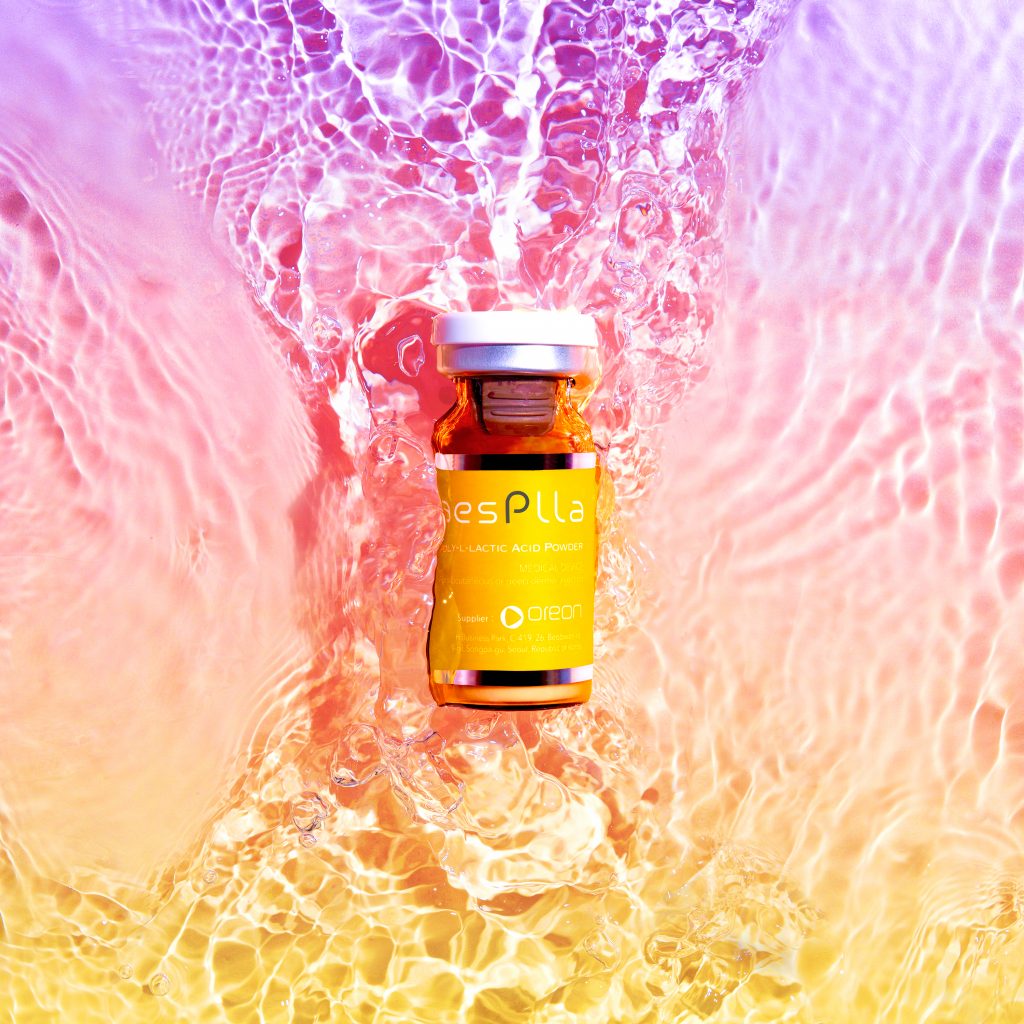aesPlla® and Sculptra are both PLLA collagen stimulators, a popular alternative to HA fillers when it comes to natural-looking volume restoration. Whilst Sculptra has been present in the European aesthetics market since 1999, aesPlla® launched in 2022 and is described as The Future of Restorative Injectables. Fox explores the differences between these two PLLA products.
Sculptra vs aesPlla®
What is Sculptra?
Sculptra is a Poly-L-Lactic Acid collagen stimulator, manufactured by Galderma, that seeks to activate the skin’s natural regenerative process to replace lost collagen and in turn, volumise the skin. Shop Sculptra on Fox Pharma here.
How Does Sculptra Work?
Sculptra subtly and gradually builds collagen over time to create harmonious results. SCULPTRA Aesthetic is an injectable implant that contains microparticles of poly-L-lactic acid (PLLA), carboxymethylcellulose (USP), non-pyrogenic mannitol (USP) and sterile water for injection, when reconstituted.
How Many Sculptra Treatments are Needed?
It is recommended to undergo 1-4 sessions of Sculptra, with a minimum of three-week intervals between each session. Patients usually require three sessions.
How Long Does it Take for Sculptra to Work?
Collagen stimulation is a gradual process, therefore the patient will be required to wait at least three weeks the effects to take place, initial results are typically visible at around the 6-week mark.
How Long Does Sculptra Last For?
Scultpra results last for around 24 months, but many patients report that their results have lasted even longer.

Sculptra Reconstitution
According to manufacturer Galderma, Sculptra should be reconstituted prior to injection, with the addition of 5ml of Sterile Water for Injection to form a sterile, non-pyrogenic suspension solution. New guidelines suggest that Sculptra can be injected after 2 hours of reconstitution, however some practitioners still prefer to reconstitute 72 hours prior to treatment.
How To Inject Sculptra
The deep dermal grid pattern is the recommended injection pattern for Sculptra. Practitioners should inject into the deep dermis with the threading technique. The injections should be placed 0.5 to 1 cm apart, injecting 0.1 mL to 0.2 mL at each site. One vial is typically required per treatment session.
Sculptra Complications
The most common post-treatment side effects of Sculptra include injection site swelling, tenderness, redness, pain, bruising, bleeding, itching and lumps. Patients may also notice small lumps under the skin when pressing on the injected area.
There have also been reported cases of larger lumps such as nodules and granulomas. These complications are difficult to resolve and can present with a delayed onset. They can sometimes be accompanied by inflammation or skin discoloration.
Can Sculptra Cause Vascular Occlusion?
Sculptra should not be injected into the blood vessels as it may cause vascular occlusion, infarction or embolic phenomena. It should only be injected into healthy skin and cannot be used to treat the vermillion of the lip or the peri-orbital area.
Practitioners should inject the product slowly, applying the least amount of pressure possible. They should immediately stop the treatment if a patient exhibits any of the following symptoms: changes in vision, signs of a stroke, blanching of the skin, or unusual pain during or shortly after the procedure. Patients should receive prompt medical attention and evaluation by an appropriate health care practitioner specialist should an intravascular injection occur.
Can Sculptra be Dissolved?
Nodules, lumps and granulomas from Sculptra often have a prolonged resolution timescale. In many cases, they resolve spontaneously on their own and smaller lumps can be dispersed by early interventional massaging. In some cases, Hyaluronidase was used to dissolve the filler or the nodule was treated using steroid injections such as Kenalog. In the most extreme cases, larger nodules may need to be surgically removed if they are unresponsive to treatment and massaging.
What is aesPlla®?
aesPlla® is a bio-stimulatory PLLA filler that stimulates collagen production for visible rejuvenation and superior longevity. It is ideal for patients aged 30+ who are seeking to restore facial volume lost through ageing or weight loss. Shop aesPlla® on Fox Pharma here.
How Does aesPlla® Work?
AesPlla utilises Poly-L-Lactic Acid, the same material used in dissolvable surgical stitches. The PLLA powder is reconstituted with Sterile Water For Injection. Once the treatment course has been completed, the results will last for up to three years. PLLA naturally bio-degrades within the body, breaking down into carbon dioxide and water. When synthetic lactic acid is injected into the foundational layers of maturing skin, the body responds by increasing collagen production. This stimulation promotes smoother, firmer skin with a noticeable increase in volumisation.
How Many aesPlla® Treatments are Needed?
aesPlla® requires three treatments, spaced four weeks apart, for optimal results.

How Long Does it Take For aesPlla® to Work?
Initial results may be visible at four weeks post-treatment. However, like Sculptra, volumisation with aesPlla® is a gradual process, as the body needs time to produce new collagen in response to the PLLA stimuli. Once the new collagen has been stimulated the skin will appear smoother and more volumised, for an altogether more youthful looking visage.
Preparation Time
aesPlla® requires 3 hours of dissolving time to reconstitute into a solution for injection.
Complications of aesPlla®
Can aesPlla®cause vascular occlusion?
aesPlla® boasts a streamlined particle structure, meaning that the filler requires significantly less injection force than traditional PLLA fillers. This helps to reduce the risk of complications such as vascular occlusion and nodules.
Does aesPlla® migrate?
aesPlla® does not migrate or attract water, allowing precise injection, exactly where needed. Thoroughly expert-tested, aesPlla® has no reported complications. This advancement in PLLA fillers greatly reduces the risk of nodules and granulomas that have been previously associated with traditional PLLA fillers.
Summary:
Both aesPlla® and Sculptra utilise the same mode of action to create natural-looking and long-lasting volumisation through collagen stimulation. The key difference between the two products lies in the formulation. aesPlla®’s streamlined particle structure greatly reduces the risk of complications such as nodules and lumps that are traditionally associated with Sculptra.
Shop PLLA fillers on Fox Pharma here.




Leave A Comment
You must be logged in to post a comment.